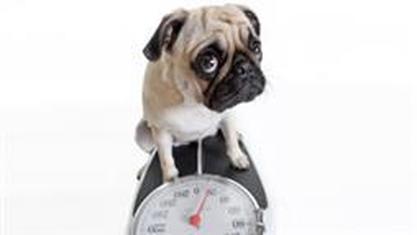|
By Dr. Karen Becker Many people believe the love they have for families and friends is best expressed through food, so serving cake, pie, biscuits and gravy and mounds of meat is considered a love language. Family recipes are sometimes thought to be part of the glue that helps holds loved ones together. Unfortunately, the concept is also extended to pets. In fact, the newest statistics show that over the past several years, pet obesity is getting worse, not better. The sad fact is, obesity continues to be the greatest health threat facing pets today. According to the Association for Pet Obesity Prevention's (APOP) 2016 clinical survey, nearly 54 percent of dogs and 59 percent of cats were deemed clinically overweight or obese, using the Pet Body Condition Score (BCS). A BCS of 4 equates to overweight, and BCS 5 is obese. According to the organization's website: "That equals an estimated 41.9 million dogs and 50.5 million cats are too heavy, based on 2016 pet population projections provided by the American Pet Products Association (APPA)."1 Since 2012, APOP's percentages for overweight and obese dogs have shown a steady climb from 52.5 percent to 53.9 percent in 2016. Over the same time frame, there was a slight dip in the percentages for 2013 for cats, but then they climbed and even exceeded the highest numbers ever with a total of 58.9 percent being obese and overweight. What Does Excess Fat in Dogs and Cats Mean for Their Health? In 2014, the American Animal Hospital Association submitted guidelines for managing the weight of dogs and cats, and noted several related diseases and conditions that may occur when these animals are overweight or obese, such as: Skin disorders, Respiratory problems, Kidney dysfunction, Metabolic and endocrine disorders, Orthopedic disease, Certain cancers, Chronic inflammation and Diminished quality of life. But that's not all. Numerous other diseases are claiming the lives of pets due to obesity, and many are related to the strain placed on their bones and joints, circulatory systems, nerves and organs, such as diabetes, osteoarthritis, hypothyroidism, congestive heart failure and intervertebral disc disease. Not surprisingly, any of these by themselves can make your pet feel miserable, but the worst thing is a reduced life expectancy. Obesity can kill animals just as it does humans. Read more... If you're unsure what your pet is supposed to weigh, you can check the list of ideal weights for pets at Pet Obesity Prevention.3 Weight charts have lots of limitations, so ideally, if you don't know if your pet is overweight, ask your vet. You should be able to feel your pet's ribs:
new blog posts on developing site www.pawsitivewellnesscenter.com
0 Comments
Your comment will be posted after it is approved.
Leave a Reply. |
Blog CreatorMary DeRoche Archives
April 2024
Categories
All
|
DISCLAIMER: I, Mary DeRoche, am not a veterinarian and do not practice medicine. I do not diagnose, cure, heal, treat disease or otherwise prescribe medication. I assist people in working with their animals in correcting energetic imbalances in their pet’s bio-field that assists the body to release its innate healing ability. When the energy chi of the body is balanced and moving correctly, the body’s innate natural energy heals itself. All healing is self-healing. Animals are affected by their environment so I also include the pet parents in my work. Animals do pick up energy from their family and environment. I only recommend the use of therapeutic grade essential oils for your pets because therapeutic grade essential oils have been tested to guarantee that they are free of synthetics, additives, toxins and any other impurities, which can result in side effects and/or inconsistent results. Essential oils and supplements are recommendations to help boost the pet’s immune system.
I recommend that clients continue to see their pet’s regular veterinarian and follow their advice and my work is a complement to regular allopathic medicine. My spiritual energy work is not a substitute for conventional medical diagnosis or treatment for any medical or psychological condition. For such issues, you should seek the proper licensed veterinarian. I am a Healing Touch for Animals Practitioner and a Subtle Energy Practitioner and my work is spiritually and energetically based and I believe all healing is spiritual in nature. I do not make any promises, warranties or guarantees about results of my work, or of the energy sessions. The energy sessions help many animals but like any energy work, it might not work for everyone. The use of essential oils, herbs and supplements is to assist the pet with balancing chakra centers for proper energy flow or chi.
© 2013~2023 Pawsitive Wellness Center All Rights Reserved.
I recommend that clients continue to see their pet’s regular veterinarian and follow their advice and my work is a complement to regular allopathic medicine. My spiritual energy work is not a substitute for conventional medical diagnosis or treatment for any medical or psychological condition. For such issues, you should seek the proper licensed veterinarian. I am a Healing Touch for Animals Practitioner and a Subtle Energy Practitioner and my work is spiritually and energetically based and I believe all healing is spiritual in nature. I do not make any promises, warranties or guarantees about results of my work, or of the energy sessions. The energy sessions help many animals but like any energy work, it might not work for everyone. The use of essential oils, herbs and supplements is to assist the pet with balancing chakra centers for proper energy flow or chi.
© 2013~2023 Pawsitive Wellness Center All Rights Reserved.



 RSS Feed
RSS Feed